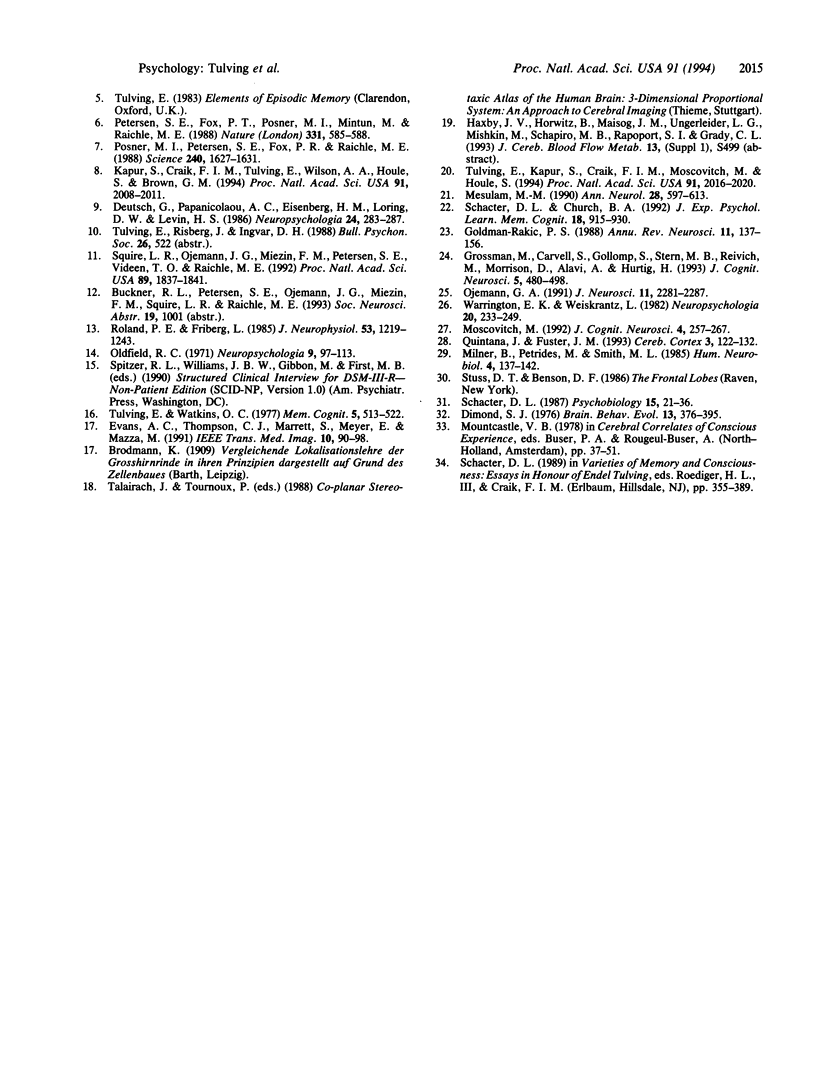Abstract
This study used positron emission tomography (PET) to investigate the neuroanatomical correlates of remembering previously experienced events. Twelve young healthy adults listened to "old" meaningful sentences which they had studied 24 hr previously. As a control task the subjects listened to comparable "new" sentences that they had never heard before. Regional cerebral blood flow associated with each task was measured by PET scans using 15O-labeled water. Comparison (old-sentence task minus new-sentence task) of the PET images revealed an extended strip of increased blood flow in the right dorsolateral prefrontal cortex (Brodmann's areas 10, 46, and 9) and the anterior portion of area 6. Other principal regions of increased blood flow were situated around the left anterior cingulate sulcus and bilaterally in the parietal lobes (areas 7 and 40). Major decreases in blood flow were situated bilaterally in the temporal lobes (areas 21, 22, 41, and 42). A high proportion of activity changes seemed to be located in the depths of cortical sulci. Increases in blood flow are seen as reflecting the operations of a widely distributed neuronal network involving prefrontal and parietal cortical regions that subserves the conscious recollection of previously experienced events. Decreases in blood flow in the temporal auditory areas are interpreted as reflecting auditory priming. The prevalence of sulcal blood-flow changes may reflect extensive cortical gyrification; it may also indicate that memory-related processes rely on the densely packed neuropil of sulcal regions.
Full text
PDF



Selected References
These references are in PubMed. This may not be the complete list of references from this article.
- Deutsch G., Papanicolaou A. C., Eisenberg H. M., Loring D. W., Levin H. S. CBF gradient changes elicited by visual stimulation and visual memory tasks. Neuropsychologia. 1986;24(2):283–287. doi: 10.1016/0028-3932(86)90062-x. [DOI] [PubMed] [Google Scholar]
- Dimond S. J. Brain circuits for consciousness. Brain Behav Evol. 1976;13(5):376–395. doi: 10.1159/000123823. [DOI] [PubMed] [Google Scholar]
- Goldman-Rakic P. S. Topography of cognition: parallel distributed networks in primate association cortex. Annu Rev Neurosci. 1988;11:137–156. doi: 10.1146/annurev.ne.11.030188.001033. [DOI] [PubMed] [Google Scholar]
- Graf P., Schacter D. L. Implicit and explicit memory for new associations in normal and amnesic subjects. J Exp Psychol Learn Mem Cogn. 1985 Jul;11(3):501–518. doi: 10.1037//0278-7393.11.3.501. [DOI] [PubMed] [Google Scholar]
- Kapur S., Craik F. I., Tulving E., Wilson A. A., Houle S., Brown G. M. Neuroanatomical correlates of encoding in episodic memory: levels of processing effect. Proc Natl Acad Sci U S A. 1994 Mar 15;91(6):2008–2011. doi: 10.1073/pnas.91.6.2008. [DOI] [PMC free article] [PubMed] [Google Scholar]
- Mesulam M. M. Large-scale neurocognitive networks and distributed processing for attention, language, and memory. Ann Neurol. 1990 Nov;28(5):597–613. doi: 10.1002/ana.410280502. [DOI] [PubMed] [Google Scholar]
- Milner B., Petrides M., Smith M. L. Frontal lobes and the temporal organization of memory. Hum Neurobiol. 1985;4(3):137–142. [PubMed] [Google Scholar]
- Ojemann G. A. Cortical organization of language. J Neurosci. 1991 Aug;11(8):2281–2287. doi: 10.1523/JNEUROSCI.11-08-02281.1991. [DOI] [PMC free article] [PubMed] [Google Scholar]
- Oldfield R. C. The assessment and analysis of handedness: the Edinburgh inventory. Neuropsychologia. 1971 Mar;9(1):97–113. doi: 10.1016/0028-3932(71)90067-4. [DOI] [PubMed] [Google Scholar]
- Petersen S. E., Fox P. T., Posner M. I., Mintun M., Raichle M. E. Positron emission tomographic studies of the cortical anatomy of single-word processing. Nature. 1988 Feb 18;331(6157):585–589. doi: 10.1038/331585a0. [DOI] [PubMed] [Google Scholar]
- Posner M. I., Petersen S. E., Fox P. T., Raichle M. E. Localization of cognitive operations in the human brain. Science. 1988 Jun 17;240(4859):1627–1631. doi: 10.1126/science.3289116. [DOI] [PubMed] [Google Scholar]
- Quintana J., Fuster J. M. Spatial and temporal factors in the role of prefrontal and parietal cortex in visuomotor integration. Cereb Cortex. 1993 Mar-Apr;3(2):122–132. doi: 10.1093/cercor/3.2.122. [DOI] [PubMed] [Google Scholar]
- Roland P. E., Friberg L. Localization of cortical areas activated by thinking. J Neurophysiol. 1985 May;53(5):1219–1243. doi: 10.1152/jn.1985.53.5.1219. [DOI] [PubMed] [Google Scholar]
- Schacter D. L., Church B. A. Auditory priming: implicit and explicit memory for words and voices. J Exp Psychol Learn Mem Cogn. 1992 Sep;18(5):915–930. doi: 10.1037//0278-7393.18.5.915. [DOI] [PubMed] [Google Scholar]
- Squire L. R., Ojemann J. G., Miezin F. M., Petersen S. E., Videen T. O., Raichle M. E. Activation of the hippocampus in normal humans: a functional anatomical study of memory. Proc Natl Acad Sci U S A. 1992 Mar 1;89(5):1837–1841. doi: 10.1073/pnas.89.5.1837. [DOI] [PMC free article] [PubMed] [Google Scholar]
- Tulving E., Kapur S., Craik F. I., Moscovitch M., Houle S. Hemispheric encoding/retrieval asymmetry in episodic memory: positron emission tomography findings. Proc Natl Acad Sci U S A. 1994 Mar 15;91(6):2016–2020. doi: 10.1073/pnas.91.6.2016. [DOI] [PMC free article] [PubMed] [Google Scholar]
- Warrington E. K., Weiskrantz L. Amnesia: a disconnection syndrome? Neuropsychologia. 1982;20(3):233–248. doi: 10.1016/0028-3932(82)90099-9. [DOI] [PubMed] [Google Scholar]


